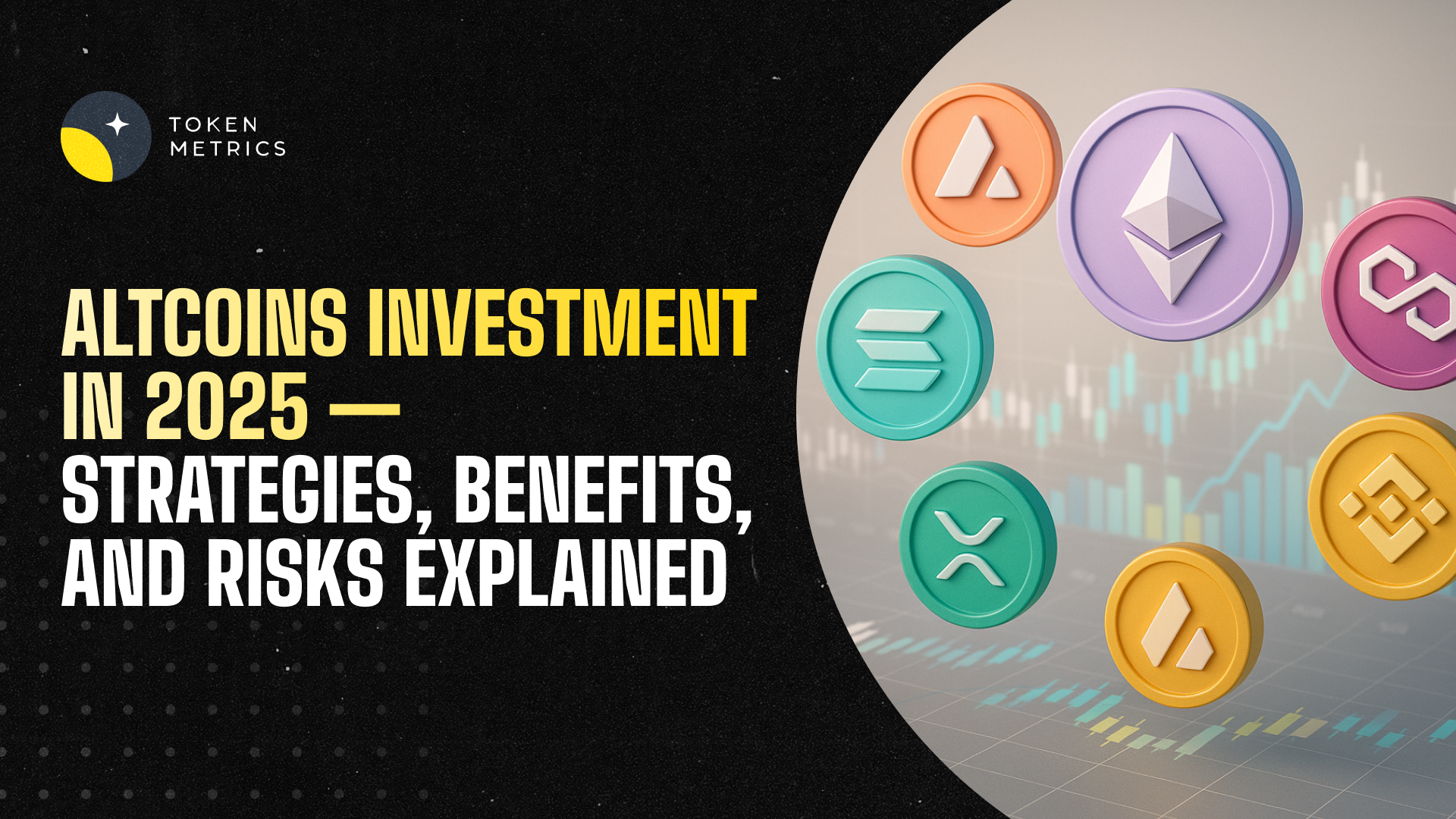
Altcoins Investment: A Comprehensive Guide for 2025

Introduction to Altcoin Investment
As the cryptocurrency market evolves, altcoins—cryptocurrencies other than Bitcoin—are becoming increasingly central to the digital asset ecosystem. Investing in altcoins can provide opportunities for higher returns, portfolio diversification, and exposure to innovative blockchain technologies.
Unlike Bitcoin, which is primarily seen as digital gold, altcoins serve varied purposes, such as powering decentralized applications, enabling smart contracts, or facilitating cross-border payments. In 2025, altcoin investments are gaining momentum among both retail and institutional investors, offering unique opportunities in emerging sectors like artificial intelligence (AI), decentralized finance (DeFi), and real-world asset tokenization.
What Are Altcoins?
Altcoins are cryptocurrencies designed as alternatives to Bitcoin. They differ in technology, use case, and governance structure, making them essential to a diversified crypto portfolio.
Categories of Altcoins include:
- Smart Contract Platforms: Examples include Ethereum (ETH), Cardano (ADA), and Solana (SOL), which enable developers to build decentralized applications (dApps).
- DeFi Tokens: Tokens like Uniswap (UNI) and Aave (AAVE) power decentralized finance ecosystems.
- AI and Analytics Tokens: Token Metrics AI (TMAI) and Fetch.ai (FET) combine AI with blockchain to deliver insights and autonomous decision-making.
- Meme Coins: Dogecoin (DOGE) and Shiba Inu (SHIB) often grow based on community support and viral trends.
- Layer 2 Solutions: Polygon (MATIC) and Arbitrum (ARB) improve scalability for existing blockchains.

By investing in a mix of these categories, investors gain exposure to multiple narratives driving the crypto market forward.
How Altcoin Investment Works
Investing in altcoins involves buying and holding tokens, trading them for profit, or staking them for passive income. The process starts with choosing a reliable cryptocurrency exchange, creating a secure wallet, and identifying which tokens fit your portfolio strategy.
Key steps for altcoin investment:
- Research & Analysis: Use AI-driven platforms like Token Metrics to analyze project fundamentals, on-chain activity, and sentiment.
- Portfolio Allocation: Decide on a mix of large-cap, mid-cap, and small-cap tokens based on risk tolerance.
- Execution & Management: Monitor performance regularly and rebalance holdings to align with market conditions.
Benefits of Investing in Altcoins
1. Higher Growth Potential:
Altcoins often outperform Bitcoin during bull markets. Projects in sectors like AI, DeFi, and NFTs can yield outsized returns when demand surges.
2. Diversification:
Altcoins provide exposure to multiple sectors, reducing reliance on Bitcoin’s price movements.
3. Innovation:
Many altcoins drive technological breakthroughs in blockchain scalability, privacy, and decentralized governance.
4. Passive Income Opportunities:
Through staking and yield farming, investors can earn consistent returns on altcoin holdings.
Risks of Altcoin Investment
While altcoins can deliver impressive gains, they also carry significant risks:
- High Volatility: Prices can fluctuate sharply, leading to rapid gains or losses.
- Project Failures: Some tokens lack strong fundamentals, increasing the risk of collapse.
- Security Threats: Hacks and smart contract exploits remain a concern in DeFi ecosystems.
- Regulatory Uncertainty: Governments worldwide are developing frameworks that may impact certain projects.
Mitigating these risks involves thorough research, diversification, and using analytics tools to assess project viability.
Altcoin Investment vs. Bitcoin Investment
Bitcoin is considered a store of value, while altcoins offer greater utility and innovation. Here’s how they compare:
- Volatility: Altcoins are more volatile but present higher growth potential.
- Use Case: Bitcoin’s primary function is as a digital currency and hedge; altcoins cater to smart contracts, DeFi, AI, and more.
- Portfolio Role: While Bitcoin provides stability, altcoins enhance diversification and upside exposure.
A balanced strategy typically includes Bitcoin for security and altcoins for growth.
Strategies for Successful Altcoin Investing
- Long-Term Holding (HODL):
Invest in fundamentally strong projects and hold through market cycles. - Swing Trading:
Capitalize on price volatility by buying low and selling high over short- to mid-term periods. - Narrative Investing:
Focus on sectors driving crypto growth—AI coins, DeFi protocols, and real-world asset tokens—to ride market narratives early. - Staking & Yield Farming:
Earn passive income by participating in DeFi protocols and securing proof-of-stake networks.
Security Measures for Altcoin Investors
Investing securely in altcoins requires:
- Cold Wallet Storage: Keep your holdings in hardware wallets to prevent hacks.
- Two-Factor Authentication (2FA): Add extra security layers to exchange accounts.
- Smart Contract Audits: Verify that DeFi projects you invest in have undergone reputable audits.
- Diversified Platforms: Avoid concentrating funds in one exchange or wallet.
Regulatory Considerations
Altcoins often face different regulatory classifications than Bitcoin, especially tokens associated with securities or DeFi platforms. In 2025, governments are increasingly requiring Know Your Customer (KYC) and Anti-Money Laundering (AML) compliance for crypto platforms.
Investors should ensure they use regulated exchanges and stay informed about local laws affecting altcoin trading.
How to Choose the Right Altcoins
When selecting altcoins to invest in:
- Check Market Cap & Liquidity: Ensure sufficient trading volume.
- Evaluate the Team & Roadmap: Strong leadership and clear milestones indicate long-term potential.
- Monitor On-Chain Metrics: Active wallets, transactions, and developer activity signal adoption.
- Leverage AI Analytics: Use Token Metrics AI to get data-driven coin ratings and insights.
The Future of Altcoin Investment
In 2025, altcoins are poised to play a transformative role in finance, AI integration, and global blockchain adoption. Tokens tied to AI analytics, DeFi platforms, and real-world assets are expected to lead the next wave of growth.
Conclusion
Altcoin investment is more than a high-risk gamble—it’s a way to participate in the future of digital finance. By understanding altcoins’ categories, benefits, risks, and strategies, investors can make informed decisions and unlock substantial growth opportunities.
With the right tools, like AI-powered analytics from Token Metrics, and a disciplined approach, altcoins can become a cornerstone of a well-balanced crypto portfolio in 2025 and beyond.

.svg)

Create Your Free Token Metrics Account

.png)




%201.svg)
%201.svg)


%201.svg)









.svg)




.png)